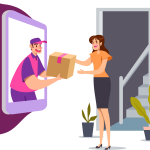As a trillion-dollar business, Amazon is both a household name and a pillar of the modern economy. The ecommerce behemoth revolutionized the industry by offering products across practically all categories with fast, free shipping, seamless returns and more convenience than any store had before. And for many consumers, it’s the gold standard for the online shopping experience.
However, Amazon has made headlines for poor treatment of workers, tricking consumers into subscribing to Prime and other unsavory practices that have some shoppers seeking alternatives. These switchers are already primed to find your online store — all you have to do is emphasize how your brand is different and better. Ready to get started?
Create a Personalized Shopping Experience
As an online retailer, you’re familiar with the power of personalization. Everyone wants to feel seen and understood, and the principle stands when applied to ecommerce. Research shows time and time again consumers are more likely to buy when the shopping experience is tailored to them. Even Amazon sees more than one-third of its revenue come from personalized product recommendations. Clearly, this shows Amazon is very good at personalization, but all hope isn’t lost. These tactics can still help your online store compete.
- Recommended products: Suggest related products based on purchase history or browsing activity.
- Personalized emails: Use consumers’ names in the emails you send them, and segment emails based on things like demographic information or purchase history.
- Dynamic landing pages: Track website visitors with cookies so you can show different pages to different shoppers.
- Special occasion coupons: Delight customers with discounts for birthdays or other milestones.
- Relevant advertisements: Showcase only relevant, targeted ads instead of mass messaging.
Go in more depth with our recent guide to ecommerce personalization.
Ramp Up Your Email Marketing
Amazon launched its native email marketing tool, called Customer Engagement, in fall of 2022. Like its other tools, it integrates directly with Seller accounts and storefronts, and users can send automated emails based on shopper behavior (welcome messages, post-purchase review requests and more.) A major drawback, however, is the limited templates sellers can use. Want to test a new design or add a second CTA? You’re out of luck.
Here, Amazon’s weakness is your area of opportunity. Email is an incredibly powerful tool, even beyond communication. Consider this: 47% of consumers prefer email as their main channel of contact from brands, and more than half of them cite email as an influence on purchasing decisions. You can directly reach your customers, evangelize your brand and ultimately supercharge your sales. Though the popularity of other digital marketing channels ebbs and flows, email marketing has always been a solid bet.
Without being limited to premade templates, you use the power of email marketing to leverage your brand’s colors, fonts, voice and imagery to tell your story and get shoppers hooked so they convert in the (hopefully near) future.
Optimize Your Website
Gone are the days of the encyclopedia, replaced with Google and the limitless knowledge users can access with simple queries. In fact, the search engine processes 8.5 billion searches per day, which means there’s ample opportunity to capture a slice of the pie.
This is where ecommerce SEO comes into play. SEO, or search engine optimization, is the process of making your website easy for Google (and other engines) to find. It’s its own art form that can take years to master, but even marketing novices can make small optimizations that will have a huge payoff.
There are two ways to increase the SEO value of your online store:
- Optimized product descriptions and
- Content marketing
Your product descriptions are a gold mine for SEO opportunities, and here’s why: If the keywords (what consumers type in the search bar) appear in the description, there’s a better chance your website will appear in the search results. Everything from the title to the alt descriptions of images and, of course, the copy you use to describe the item is key. Use a keyword research tool to see what shoppers are searching for, and get to crafting the perfect product descriptions! For more of a deep dive, check out our ultimate guide to optimizing product descriptions for search.
Content marketing is another avenue that can increase search traffic to your website. Writing blogs is a tried-and-true way to establish your brand as the “authority” on whatever you sell. How-to articles, in-depth reviews, rankings and listicles are just some of the types of content to create that will drive more shoppers to your online store.
Go Green
Amazon isn’t exactly known for its earth-friendly practices. The company emits 71.54 million metric tons of carbon dioxide per year delivering products to customers, oftentimes on the same or next day. And with the rise of eco-consciousness among consumers, many are looking to reduce their carbon footprints and support the businesses that are doing the same.
Need some ideas for going green? Don’t miss our guide to ecommerce sustainability, but here’s the short version:
- Reduce your packaging: Less packaging means less waste.
- Use cleaner energy: Research renewable energy sources in your area, such as wind or solar, to power your operations.
- Source eco-friendly products: Recyclable or biodegradable materials are more sustainable.
- Create a recycling program: Partner with a recycling company to make the process easier, or offer incentives for recycling.
- Support local: Reduce transportation costs by buying local materials or products to sell online.
Yes, You Can Compete with Amazon!
While competing with Amazon as an online retailer may seem like a daunting task, it’s not impossible. By emphasizing the ways your brand is different and delivering the types of shopping experiences consumers are seeking, you can carve out your own space in the digital landscape.
Remember, success doesn’t come overnight, but with perseverance, innovation, and a deep understanding of your target audience, you can thrive as an online retailer, even in the shadow of giants like Amazon. So, go ahead and put these strategies into action, and let your passion and dedication guide you towards building a thriving online business that can stand tall amidst the competition. Best of luck on your journey!











